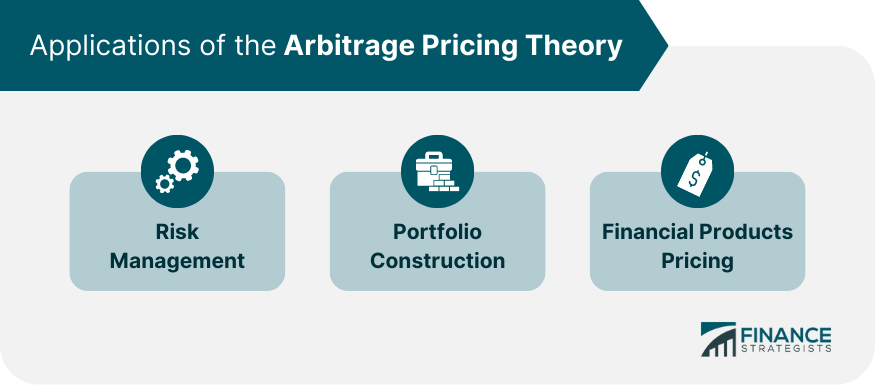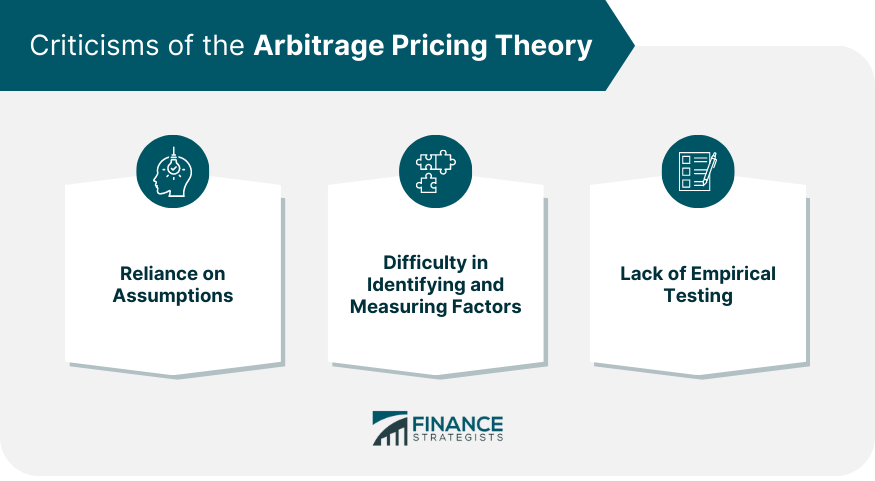Arbitrage Pricing Theory is a financial model that explains the expected returns on assets or securities by considering multiple sources of systematic risk. It posits that the return on any given asset is a linear function of various independent factors, which represent the systematic risks in the market. The theory assumes that any potential arbitrage opportunities that arise from mispricing will be exploited by investors until the prices adjust and the arbitrage opportunities disappear. APT has become an essential tool in modern finance, as it offers a more comprehensive approach to analyzing asset returns compared to traditional models like CAPM. By incorporating multiple factors, it enables investors to better understand the risks associated with their investment portfolios and make more informed decisions. APT has also laid the foundation for the development of numerous other multifactor models and quantitative investment strategies. The concept of APT was first introduced by economist Stephen Ross in 1976. Ross sought to provide an alternative to the widely used Capital Asset Pricing Model (CAPM) and its single-factor representation of risk. His work on APT led to the development of a multifactor model that accounts for a variety of sources of systematic risk, thus providing a more nuanced and flexible framework for understanding asset pricing and returns. APT assumes that an asset's return is influenced by several independent factors, which represent different sources of systematic risk. These factors could include macroeconomic variables such as interest rates, inflation, GDP growth, or industry-specific risks. The theory assumes that there exist arbitrage opportunities due to mispricing in the market. Arbitrage refers to the practice of taking advantage of price differences between assets or securities in different markets or between different time periods to earn risk-free profits. APT asserts that investors will exploit these opportunities, thereby eliminating any mispricing. APT assumes that there is a linear relationship between an asset's return and the factors influencing it. In other words, the asset's return can be modeled as the sum of the product of the sensitivity of the asset to each factor and the factor's return. The theory posits that idiosyncratic risk, or the risk specific to an individual asset, can be eliminated through diversification. By holding a well-diversified portfolio, investors can reduce the impact of idiosyncratic risk on their overall investment returns. The APT model can be represented mathematically as follows: E(R) = Rf + β1 * RP1 + β2 * RP2 + ... + βn * RPn Where: E(R) = the expected return of the asset Rf = the risk-free rate of return β1, β2, ..., βn = the sensitivities of the asset's return to the systematic risks (also known as factor loadings) RP1, RP2, ..., RPn = the risk premiums associated with each systematic risk factor The APT formula suggests that an asset's expected return is equal to the risk-free rate plus a sum of risk premiums, each multiplied by its respective factor loading. These factor loadings reflect the asset's sensitivity to different systematic risks in the market. If an asset is more sensitive to a particular systematic risk, it will have a higher factor loading and a higher expected return, all else being equal. While both APT and CAPM are used to estimate expected returns and measure risk, they differ significantly in their underlying assumptions and complexity. CAPM is a single-factor model that only considers market risk, as represented by the beta of the asset. In contrast, APT is a multifactor model that considers multiple sources of systematic risk. This makes APT more flexible and potentially more accurate than CAPM, but also more complex to implement due to the need to identify and measure multiple factors. APT is a type of multi-factor model, but it differs from other multi-factor models in its assumption of arbitrage opportunities and its linear representation of the relationship between returns and factors. Other multi-factor models may not assume arbitrage opportunities and may use non-linear functions to represent the relationship between returns and factors. This can make APT more straightforward to apply, but potentially less accurate in capturing the complexities of financial markets. APT and MPT are complementary theories that provide different perspectives on portfolio management. MPT focuses on the relationship between risk and return in a portfolio and emphasizes the benefits of diversification. APT, on the other hand, provides a framework for estimating expected returns based on multiple sources of systematic risk. By combining the insights from both theories, investors can construct portfolios that balance risk and return effectively. APT can be used in risk management to identify and measure the sources of risk in a portfolio. By understanding the factors that drive asset returns, investors can make adjustments to their portfolios to manage these risks effectively. For example, if an investor finds that their portfolio is highly sensitive to interest rate changes, they may choose to reduce their exposure to interest rate-sensitive assets. APT is also a valuable tool for portfolio construction. It can be used to determine the optimal weights for different assets in a portfolio to maximize expected return for a given level of risk. By considering multiple factors, APT allows for a more nuanced approach to portfolio construction than traditional methods based on expected return and variance alone. In addition to its applications in portfolio management, APT is also used in the pricing of financial products. For example, it can be used to price derivatives by considering the systematic risks that influence the underlying asset. Similarly, it can be used in the pricing of insurance products by considering the systematic risks that influence claim frequencies and severities. While APT is a powerful tool for understanding asset returns, it is based on several assumptions that may not hold in practice. For example, it assumes that there exist arbitrage opportunities, which may not always be the case due to market inefficiencies or transaction costs. It also assumes that idiosyncratic risk can be eliminated through diversification, which may not be feasible for investors with limited resources or access to a diverse range of assets. Another challenge with APT is identifying and measuring the factors that influence asset returns. These factors are often not directly observable and must be inferred from market data, which can introduce measurement error. Furthermore, the relevance of different factors may change over time, requiring constant updating of the model. Despite its theoretical appeal, APT has been subject to limited empirical testing. This is due to its complexity and the challenges associated with identifying and measuring multiple factors. As a result, there is ongoing debate about the validity and practical applicability of APT in different financial contexts. Arbitrage Pricing Theory is a multifactor model that seeks to explain the expected return of an asset based on various systematic risks. It assumes the existence of arbitrage opportunities and a linear relationship between returns and factors, and it posits that idiosyncratic risk can be diversified away. APT provides a more comprehensive and flexible framework for understanding asset returns compared to single-factor models like CAPM. It has numerous applications in risk management, portfolio construction, and financial product pricing. However, it also faces criticisms related to its assumptions, the difficulty of identifying and measuring factors, and the lack of empirical testing. The complexities of applying APT suggest the importance of consulting financial professionals when making investment decisions. While APT offers valuable insights into asset pricing, it should be used in conjunction with other models and tools, and interpreted in the context of the broader investment environment. As with any financial model, APT is not a magic bullet, but a tool to assist in making informed decisions.What Is the Arbitrage Pricing Theory (APT)?
History and Development of APT
Assumptions of the Arbitrage Pricing Theory
Multiple Factors Influence Returns
Arbitrage Opportunities Exist
Linear Relationship Between Returns and Factors
Idiosyncratic Risk is Diversifiable
The Mathematical Model of Arbitrage Pricing Theory
The Formula for APT
Arbitrage Pricing Theory vs Other Asset Pricing Models
APT vs Capital Asset Pricing Model (CAPM)
APT vs Multi-Factor Models
APT vs Modern Portfolio Theory (MPT)
Applications of the Arbitrage Pricing Theory
Risk Management
Portfolio Construction
Financial Products Pricing

Criticisms of the Arbitrage Pricing Theory
Reliance on Assumptions
Difficulty in Identifying and Measuring Factors
Lack of Empirical Testing

Final Thoughts
Arbitrage Pricing Theory (APT) FAQs
Arbitrage Pricing Theory is a financial model used to determine the relationship between the expected return of an asset and its systematic risk. It suggests that the expected return of an asset can be explained by multiple factors rather than just the market's overall movement.
While the CAPM focuses on a single factor, the market return, APT considers multiple factors that affect the expected return of an asset. APT allows for a more comprehensive analysis of an asset's risk and return by incorporating various systematic factors.
Arbitrage Pricing Theory relies on a few key assumptions. First, it assumes that asset returns can be explained by a linear relationship with multiple factors. Second, it assumes that investors are risk-averse and seek to maximize their expected utility. Lastly, it assumes that no arbitrage opportunities exist, meaning it is impossible to earn riskless profits by exploiting price differences in the market.
In practice, the Arbitrage Pricing Theory is used to estimate the expected return of an asset based on its exposure to various factors. Analysts identify and analyze factors that are likely to influence the asset's return, such as interest rates, inflation, market volatility, or industry-specific variables. By considering the asset's sensitivity to these factors, they can estimate its expected return.
APT plays a crucial role in portfolio management by assisting in the construction of well-diversified portfolios. By considering the sensitivity of assets to various factors, APT helps identify assets that may offer higher expected returns based on their risk exposure. It enables portfolio managers to make informed decisions about asset allocation and risk management, aiming to optimize the risk-return tradeoff of the portfolio.
True Tamplin is a published author, public speaker, CEO of UpDigital, and founder of Finance Strategists.
True is a Certified Educator in Personal Finance (CEPF®), author of The Handy Financial Ratios Guide, a member of the Society for Advancing Business Editing and Writing, contributes to his financial education site, Finance Strategists, and has spoken to various financial communities such as the CFA Institute, as well as university students like his Alma mater, Biola University, where he received a bachelor of science in business and data analytics.
To learn more about True, visit his personal website or view his author profiles on Amazon, Nasdaq and Forbes.















